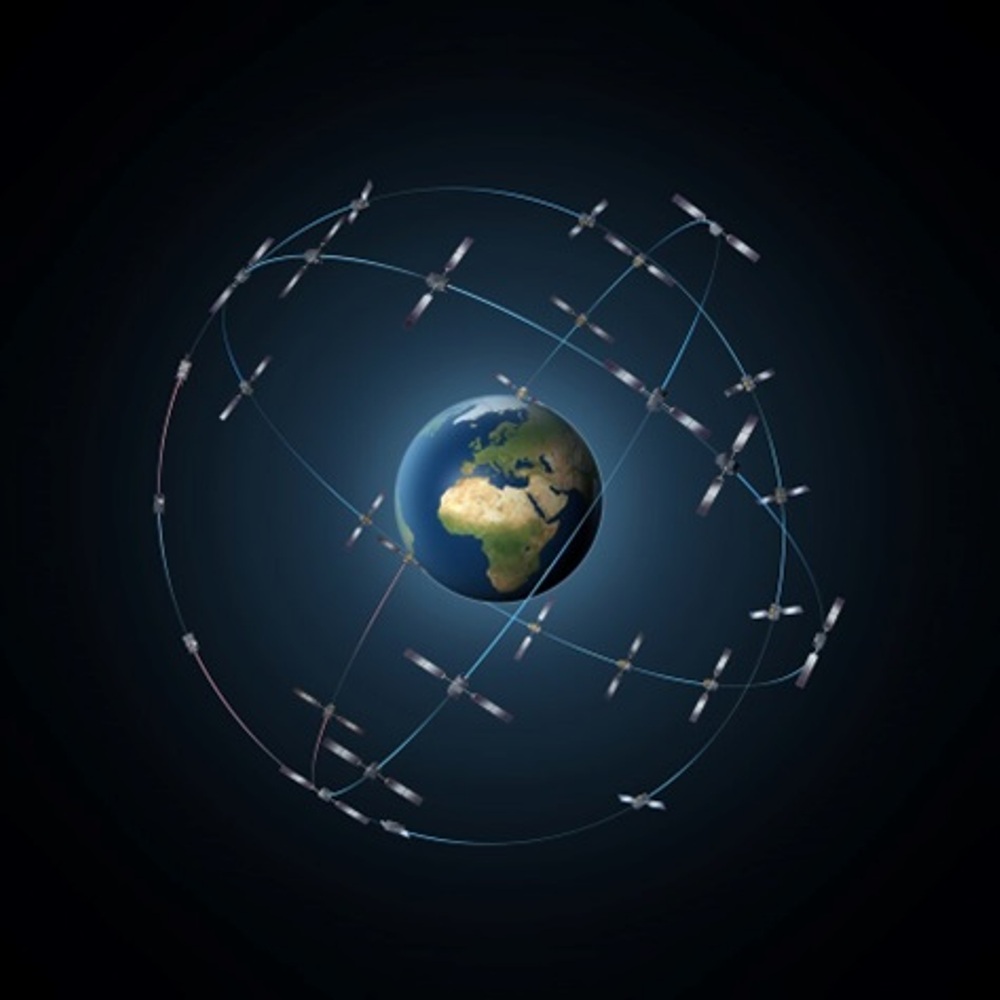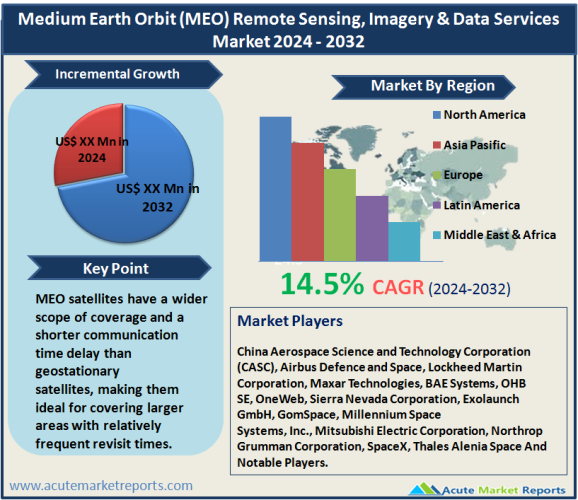
The medium earth orbit (MEO) remote sensing, imagery & data services market is expected to grow at a CAGR of 14.5% during the forecast period of 2024 to 2032. Medium earth orbit (MEO) remote sensing, imagery & data services market encompasses a range of satellite technologies positioned in medium Earth orbit, typically between 2,000 and 35,786 kilometers above the Earth. This market segment is instrumental in providing data and imagery for various applications including environmental monitoring, weather forecasting, maritime navigation, and global communications. MEO satellites have a wider scope of coverage and a shorter communication time delay than geostationary satellites, making them ideal for covering larger areas with relatively frequent revisit times. This sector is crucial for enhancing real-time data gathering capabilities across multiple industries.
Driver 1: Advancements in Satellite Technology
Innovations in Satellite Design and Functionality
Recent advancements in satellite technology have significantly enhanced the capabilities of MEO satellites, primarily through improvements in payload sensors, onboard data processing, and energy efficiency. These enhancements allow for finer resolution of imagery, higher data collection capacity, and longer operational lifespans of satellites. For example, developments in synthetic aperture radar (SAR) and multispectral imaging technologies have drastically improved the quality and utility of data that MEO satellites can provide, enabling more precise observations of Earth for climate monitoring, disaster management, and urban planning.
Integration of AI and Machine Learning
The integration of artificial intelligence (AI) and machine learning algorithms into MEO satellite systems has transformed data processing, enabling the satellites to provide more accurate and actionable insights faster than ever before. AI applications in MEO satellite systems help in automatic image recognition, anomaly detection, and predictive analytics, which are crucial for timely and effective decision-making in areas like agricultural management and emergency response.
Enhanced Communication Systems
The development of more robust and efficient communication systems for MEO satellites ensures that the vast amounts of data collected can be transmitted back to Earth quickly and securely. Innovations such as laser communication technology have been pivotal, offering faster data rates and reduced interference compared to traditional radio frequency systems. This is particularly important for applications that rely on near-real-time data transmission, such as maritime surveillance and tactical military operations.

Driver 2: Increasing Demand for Global Navigation Systems
Expansion of Global Navigation Satellite Systems (GNSS)
There is a growing demand for enhanced global navigation satellite systems, which rely heavily on MEO satellites. These systems are vital for a broad spectrum of applications, from personal navigation on smartphones to precision farming and autonomous driving. The expansion of these systems enhances the precision and reliability of location-based services worldwide, driving further investments and developments in the MEO market.
Support for International Transportation and Logistics
As global transportation and logistics become more complex, the need for accurate and reliable navigation systems becomes more critical. MEO satellites provide essential data that supports the efficiency and safety of air and maritime navigation, optimizing routes to reduce fuel consumption and increase safety. The dependency on high-quality, continuous satellite data is crucial for these sectors, underscoring the growth in the MEO satellite market.
Advancements in Urban and Rural Planning
The accurate geospatial data provided by MEO satellites is also pivotal for urban and rural planning. Governments and planning authorities utilize this data to manage and monitor urban expansion, optimize land use, and plan infrastructure developments effectively. This increasing reliance on detailed geospatial data is a significant driver for the MEO remote sensing market.
Restraint: High Costs Associated with MEO Systems
Financial Challenges in Satellite Development and Launch
The development, launch, and maintenance of MEO satellites involve high costs, which can be a significant restraint for the market. The intricate design and sophisticated technology required for these satellites necessitate substantial initial investments, as well as ongoing operational expenses. Additionally, the insurance costs associated with satellite launches, which are intended to mitigate the financial risk of launch failures and on-orbit anomalies, further add to the overall expenses. This financial burden can limit the frequency of satellite updates and the expansion of existing satellite constellations, potentially restraining the growth of the MEO remote sensing, imagery, and data services market.
Market Segmentation by Service Type
The MEO Remote Sensing, Imagery & Data Services Market is segmented into Image Data and Data Analytics Services, with each category showing distinctive growth rates and revenue impacts. Image data services, which involve the direct delivery of processed imagery from MEO satellites to end-users, currently generate the highest revenue. This segment benefits from the widespread application in sectors such as agriculture, emergency response, and environmental monitoring, where real-time or near-real-time visual data is critical for operational decision-making and strategic planning. Despite its substantial revenue contribution, data analytics services are projected to have the highest Compound Annual Growth Rate (CAGR) from 2024 to 2032. The surge in demand for these services stems from the growing need for advanced analytics and deeper insights into large datasets that MEO satellites collect. Industries such as maritime, defense, and urban planning increasingly rely on comprehensive analyses provided by these services to predict patterns, enhance security measures, and implement efficient resource management strategies. This shift toward higher complexity in data interpretation and the rising integration of AI and machine learning technologies in data analytics further amplify the growth potential of this segment, positioning it as a key driver of future market expansion.
Market Segmentation by Deployment
In the MEO Remote Sensing, Imagery & Data Services Market, the deployment categories include Public Cloud, Private Cloud, and Hybrid Cloud, each catering to different security, scalability, and data management needs. The Public Cloud segment currently leads in revenue, benefiting from its cost-effectiveness and ease of scalability which appeals to a wide range of customers, from government agencies to small enterprises. This deployment type is particularly favored for less sensitive applications where the convenience of on-demand resource availability and minimal maintenance is prioritized. On the other hand, the Hybrid Cloud is expected to experience the highest Compound Annual Growth Rate (CAGR) from 2024 to 2032. This growth is driven by the increasing demand for flexible solutions that combine the security benefits of private clouds with the scalability of public clouds. Hybrid deployments are particularly attractive in industries such as defense and multinational enterprises, where data security is paramount yet access to expansive cloud resources is necessary. This segment's growth is also supported by the ongoing digital transformation initiatives in various sectors, encouraging the adoption of cloud architectures that can support both high-performance computing tasks and stringent data sovereignty requirements.
Geographic Trends
The MEO Remote Sensing, Imagery & Data Services Market exhibits distinct geographic trends, driven by varying regional advancements in space technology, government policies, and application sectors. North America currently dominates the market in terms of revenue, supported by robust investments in space technology, a strong institutional framework, and the presence of major industry players like Lockheed Martin Corporation and Northrop Grumman Corporation. The region benefits from advanced research and development capabilities and substantial government and defense expenditures on satellite technologies. However, the Asia-Pacific region is anticipated to have the highest Compound Annual Growth Rate (CAGR) from 2024 to 2032. This expected growth is fueled by increasing space missions by countries like China and India, rising investments in space technologies, and growing applications in commercial sectors such as agriculture, urban development, and disaster management. The strategic initiatives and collaborations among countries to enhance their satellite capabilities are significantly contributing to the rapid growth of the MEO market in this region.
Competitive Trends and Key Strategies
The competitive landscape of the MEO Remote Sensing, Imagery & Data Services Market is characterized by the presence of key players such as China Aerospace Science and Technology Corporation (CASC), Airbus Defence and Space, Lockheed Martin Corporation, Maxar Technologies, BAE Systems, OHB SE, OneWeb, Sierra Nevada Corporation, Exolaunch GmbH, GomSpace, Millennium Space Systems, Inc., Mitsubishi Electric Corporation, Northrop Grumman Corporation, SpaceX, and Thales Alenia Space. These companies collectively hold a significant share of the market, driven by their comprehensive satellite offerings, continuous innovation, and strategic global alliances. In 2022, companies like Lockheed Martin and Northrop Grumman led in revenue within this sector, primarily due to their longstanding contracts with national defense and aerospace agencies.
From 2024 to 2032, these entities are expected to focus on expanding their global footprint, enhancing the capability of their satellite platforms, and developing partnerships to support worldwide connectivity and data services. The strategy of forming alliances and partnerships is particularly prevalent among companies aiming to expand their reach in emerging markets and capitalize on the local growth opportunities. For instance, SpaceX and OneWeb are focusing on creating satellite constellations that offer global broadband coverage, which is expected to be pivotal in bridging the digital divide in underserved regions. Additionally, the emphasis on incorporating advanced technologies such as AI and machine learning for data analysis is expected to be a key strategy for companies like Maxar Technologies and Airbus Defence and Space, aiming to offer differentiated and value-added services to their clients. Furthermore, the increasing trend of miniaturization of satellites and the deployment of satellite constellations in MEO are likely to be strategic focuses for smaller companies like GomSpace and Millennium Space Systems, enabling them to compete effectively with larger corporations by offering cost-efficient and tailored solutions to meet the diverse needs of their clientele.
Historical & Forecast Period
This study report represents analysis of each segment from 2022 to 2032 considering 2023 as the base year. Compounded Annual Growth Rate (CAGR) for each of the respective segments estimated for the forecast period of 2024 to 2032.
The current report comprises of quantitative market estimations for each micro market for every geographical region and qualitative market analysis such as micro and macro environment analysis, market trends, competitive intelligence, segment analysis, porters five force model, top winning strategies, top investment markets, emerging trends and technological analysis, case studies, strategic conclusions and recommendations and other key market insights.
Research Methodology
The complete research study was conducted in three phases, namely: secondary research, primary research, and expert panel review. key data point that enables the estimation of Medium Earth Orbit (MEO) Remote Sensing, Imagery & Data Services market are as follows:
Market forecast was performed through proprietary software that analyzes various qualitative and quantitative factors. Growth rate and CAGR were estimated through intensive secondary and primary research. Data triangulation across various data points provides accuracy across various analyzed market segments in the report. Application of both top down and bottom-up approach for validation of market estimation assures logical, methodical and mathematical consistency of the quantitative data.
| ATTRIBUTE | DETAILS |
|---|---|
| Research Period | 2022-2032 |
| Base Year | 2023 |
| Forecast Period | 2024-2032 |
| Historical Year | 2022 |
| Unit | USD Million |
| Segmentation | |
Service Type
| |
Deployment
| |
Industry Vertical
| |
|
Region Segment (2022-2032; US$ Million)
|
Key questions answered in this report